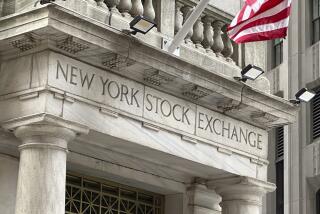Surprise! Bolsa Has a Boffo First Quarter
MEXICO CITY — Quick: Name the hemisphere’s highest-flying stock market in the first quarter.
No, not New York’s. Not Chile’s. Try Mexico’s Bolsa.
You remember--the stock market that became synonymous with “heartburn” for investors after the devaluation of the peso in 1994.
Mexico remains mired in its worst recession in six decades. And no one is predicting a return to the soaring market of the early 1990s. In fact, the market followed Wall Street earlier this week, performing the kind of swan dive you normally see off Acapulco’s cliffs.
But in the first quarter of this year, the Bolsa index rose nearly 16% in dollar terms--the highest for that of any major economy--according to figures compiled by Goldman, Sachs & Co.
“Amazing, isn’t it?” said Alexander Anderson, head of research at the Abaco brokerage house in Mexico City. “People have been aggressively negative on Mexico for the past year or so--for very understandable reasons. Many people in New York have written it off. Perhaps they’ll be surprised on the upside.”
But the road ahead for the Bolsa may contain a lot of potholes. On Tuesday, the market’s key IPC index fell by 11 points, or 0.38%, to 3,009.49. A day earlier, it had plunged 2.12%, following the Wall Street decline prompted by a jump in long-term interest rates. By Wednesday it had recovered only partly, closing up 35.12 points, or 1.17%.
The sharp rise in U.S. interest rates could be bad news for Latin American countries, which must jack up their own rates to compete for investment money.
In addition, with the peso expected to weaken soon because of high inflation and the still-frail Mexican banking sector, the market could take months--or years--to return to its pre-devaluation level in dollar terms.
The Bolsa’s strong performance in the first three months of 1996 was Part II of a rally that began in November. At that point, analysts say, investors began to detect glimmers of a recovery from Mexico’s disastrous recession and decided stocks were cheap.
An unusually steady peso and a slight decline in interest rates this year contributed to keeping the Bolsa buoyant.
The peso, which weakened from 5.5 to 7.6 to the dollar in 1995, was holding steady at 7.5 by the end of March.
Mexico “has had a little good luck and a little good policy,” said Darryl McLeod, senior economist in global economics at Lehman Bros. in New York. He was alluding to the central bank’s tight grip on the money supply, which has contributed to the peso’s stability.
In the first quarter, the Mexican Bolsa advanced faster than its counterparts in the United States (4.9%), Hong Kong (11.5%) and Singapore (8.3%), according to the Goldman Sachs index, based on baskets of stocks in 26 major markets.
Still, analysts point out that the Mexican stock market advanced so much partly because it started from such a low base.
“All we’ve done is rally back to the highs of July, August and September of last year,” said Geoffrey Dennis, director of emerging markets equity research at Bear Stearns & Co. in New York. In peso terms, the market index has surpassed its level before the December 1994 devaluation, which prompted the economic crisis.
The day before the devaluation, the index closed at 2,231.11. Afterward, the market crumbled, with the index eventually reaching a low of 1,447.62 on Feb. 27, 1995.
Measured in dollars, the index would have to climb another 2,000 points before it reached its pre-crisis level, Dennis said.
That won’t happen soon, analysts say.
The peso, they say, will undoubtedly weaken, thanks to a rate of inflation that has totaled 8.35% so far this year.
And interest rates are still high. Because of the jump in yields on the 30-year U.S. Treasury bond, the interest rate on the bellwether 28-day Cetes bill rose on Tuesday, from 36.99% to 37.43%.
High rates increase borrowing costs, hurting the profits of publicly owned companies. They also crimp economic growth by discouraging demand for everything from factory machinery to a new family Chevrolet.
“The big thing is to get rates down below 35%,” McLeod said. “Otherwise recovery is just not possible.”
Foreign investors, who rushed into Mexico’s markets in the early 1990s, are still mostly on the sidelines. And with the banking system reeling from customers’ inability to repay high-priced loans, fresh lending is scarce.
“Mexico has kind of turned around,” said John Purcell, head of Latin American equity strategy at Salomon Bros. in New York, “but it’s going to be a hard slog. Generating growth will be tough.”
(BEGIN TEXT OF INFOBOX / INFOGRAPHIC)
A Bolsa Boost
After bottoming out in February 1995, the Mexican stock market’s Bolsa index has been climbing. Monthly closes, and latest:
Wednesday: 3,044.61
Source: Bloomberg Business News
More to Read
Inside the business of entertainment
The Wide Shot brings you news, analysis and insights on everything from streaming wars to production — and what it all means for the future.
You may occasionally receive promotional content from the Los Angeles Times.










